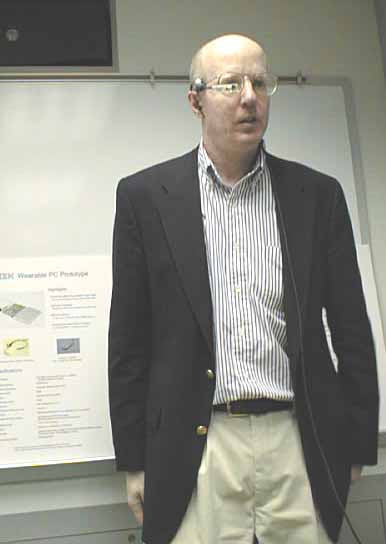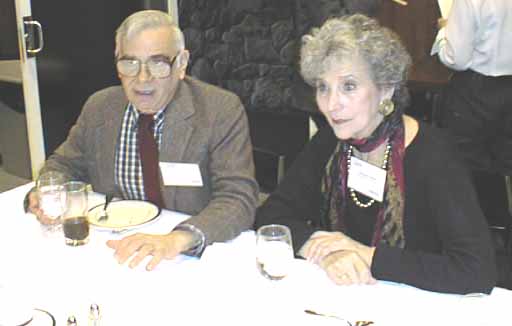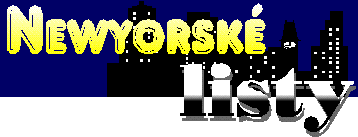
|
It was a beautiful, sunny and brisk fall day and the trip itself was an introduction to THE DAY.
On the bus we refreshed our recollection of the one time monopolizing giant in the digital technology and what the little IBM brochure left out of the "digital" history since 1890.
They (the people of monopolizing giant) were looking upon us in 1976 as on very amateurish tinkers,

|
It was the age of "MICRO". A little "micro-man" quit his school to make the "Dartmouth-basic" user friendly. But he also wanted to point out he is out of the throat-cutting hardware business, so he added the "soft" to the name. The "Microsoft Basic" was born and sold "exclusively", later also as "Radio Shack (TRASH) Basic" and later to many (probably all) other garage-type microcomputer manufacturers under their "exclusive" names. Yes, IBM was there, above us, silently watching and staying away from that crazy "micro" till 1980. Then, they (IBM) open their eyes and as everybody else came to the "micro-man" (Bill Gates) not only to name his basic the "IBM-basic" but also to write a DOS (Disk Operating System) for their 16-bit machine as the IBM-DOS which Bill had the right to use (sell) also independently as the Microsoft-DOS. The beginning of the fall of the giant monopolizing IBM.

|
The IBM account executives skilled to deal with giant corporations and banks about their IBM giant mainframe were lost in the new "micro" world where processing speed was getting faster and faster (for less) and the memory larger and cheaper every day. And so the giant IBM was falling and falling.
Arriving at the Center we realized that the IBM (the stock) recovered from $45 to $145 in a very short time so the IBM (the company) must do something right and we were here to discover it!

|
It was a 180-degree turn for the IBM. While talking about "micro" smart devices and user friendliness, the one time "micro-man" who made the basic friendly (Bill Gates) is facing Federal Judge to answer allegation of monopoly. What a difference a two decades made!
Followed by Senior Vice-President - Research Paul Horn came the real surprise in showing the new IBM accomplishments:
Paul was holding in his hand the newly invented "micro" HD (hard drive) only 1" and was talking something about "gigabytes". Remember from the history, in 1976 we were talking in terms of "kilobytes" - kilo = one thousand. (There was even a very popular magazine named Kilobyte.) - Then came the age of "megabytes" - mega = thousand of kilos - and now the giga = thousand of megas.

holding the one inch HD |
Paul was explaining the IBM vision for the future. They (IBM) even have already names for it, for storage "yotta-bytes" = thousand gigas. (thanks Irving for spelling it for me).
It would be a very long list of IBM innovations and overly technical, such as AMLCD (Active Matrix Liquid Crystal Display) based upon IBM breakthrough to use aluminum and copper instead of the metals traditionally used in display, molybdenum and tungsten.
On a question of our NY correspondent for a Hon Kong daily about IBM using "cheap labor" namely from China and India, Paul pointed out that they deal mainly through universities not only there but all around the world since IBM has the ambition to recruit the very best young people from all over the world.
Its project director Russell Budd pointed out that it is only a prototype. A small box to fit (wear) in your pocket with Intel 233 MM Pentium, 64 MB RAM and the one inch 340 MB HD.
So what? Should I carry a 27" monitor with it?
Russ has the answer!

wearing the "Wearable" |
It is a half inch plastic cube, actually mounted on about two inch platform (so you can handle it) and with a microphone on a "micro" gooseneck mounted to headphone at short distance from user's eye. Russ is wearing it on the picture on the left. Since you cannot see it, here is the detailed enlargement:

You can actually see a screen similar to active color 26" monitor viewing it from 6' distance. Very clearly and all in super bright colors.
Absolutely spectacular! Yes, they developed sort of a hand-held mouse but it is not needed since the "wearable" has full capacity to follow your voice commands.

|
Another interesting afternoon session was on the security and views presented by dr. Charles Palmer. He and his world-class "ethical hackers" have a unique character - and IBM's customers can breathe a lot easier because of it.
This group follows all what goes on in the security field, including monitoring the underground and issues warning in public interest.
The excursion was a well spent day and the trip back to New York was just as pleasant as the morning trip during sunny day
DISCLAIMER: The representations in this article are the authors own, there should be no connection with the sponsoring FPA of any kind nor with the IBM and the actual statemets could differ from the IBM.
The digital pictures were taken with a Japanese camera made in Korea downloaded to Adobe Photoshop ver. 4.
Copyright � 1998 Newyorske listy (New York Herald) *All rights reserved* ISSN 1093-2887
 Nezavisle ceske elektronicke noviny ***
Nezavisle ceske elektronicke noviny ***